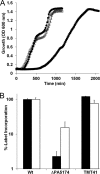Fatty acid biosynthesis in Pseudomonas aeruginosa is initiated by the FabY class of β-ketoacyl acyl carrier protein synthases
- PMID: 22753059
- PMCID: PMC3457228
- DOI: 10.1128/JB.00792-12
Fatty acid biosynthesis in Pseudomonas aeruginosa is initiated by the FabY class of β-ketoacyl acyl carrier protein synthases
Abstract
The prototypical type II fatty acid synthesis (FAS) pathway in bacteria utilizes two distinct classes of β-ketoacyl synthase (KAS) domains to assemble long-chain fatty acids, the KASIII domain for initiation and the KASI/II domain for elongation. The central role of FAS in bacterial viability and virulence has stimulated significant effort toward developing KAS inhibitors, particularly against the KASIII domain of the β-acetoacetyl-acyl carrier protein (ACP) synthase FabH. Herein, we show that the opportunistic pathogen Pseudomonas aeruginosa does not utilize a FabH ortholog but rather a new class of divergent KAS I/II enzymes to initiate the FAS pathway. When a P. aeruginosa cosmid library was used to rescue growth in a fabH downregulated strain of Escherichia coli, a single unannotated open reading frame, PA5174, complemented fabH depletion. While deletion of all four KASIII domain-encoding genes in the same P. aeruginosa strain resulted in a wild-type growth phenotype, deletion of PA5174 alone specifically attenuated growth due to a defect in de novo FAS. Siderophore secretion and quorum-sensing signaling, particularly in the rhl and Pseudomonas quinolone signal (PQS) systems, was significantly muted in the absence of PA5174. The defect could be repaired by intergeneric complementation with E. coli fabH. Characterization of recombinant PA5174 confirmed a preference for short-chain acyl coenzyme A (acyl-CoA) substrates, supporting the identification of PA5174 as the predominant enzyme catalyzing the condensation of acetyl coenzyme A with malonyl-ACP in P. aeruginosa. The identification of the functional role for PA5174 in FAS defines the new FabY class of β-ketoacyl synthase KASI/II domain condensation enzymes.
Figures










Comment in
-
Will the initiator of fatty acid synthesis in Pseudomonas aeruginosa please stand up?J Bacteriol. 2012 Oct;194(19):5159-61. doi: 10.1128/JB.01198-12. Epub 2012 Jul 20. J Bacteriol. 2012. PMID: 22821980 Free PMC article. No abstract available.
Similar articles
-
An atypical 3-ketoacyl ACP synthase III required for acyl homoserine lactone synthesis in Pseudomonas syringae pv. syringae B728a.Appl Environ Microbiol. 2024 Mar 20;90(3):e0225623. doi: 10.1128/aem.02256-23. Epub 2024 Feb 28. Appl Environ Microbiol. 2024. PMID: 38415624 Free PMC article.
-
Pseudomonas aeruginosa directly shunts β-oxidation degradation intermediates into de novo fatty acid biosynthesis.J Bacteriol. 2012 Oct;194(19):5185-96. doi: 10.1128/JB.00860-12. Epub 2012 Jun 29. J Bacteriol. 2012. PMID: 22753057 Free PMC article.
-
Alteration of the fatty acid profile of Streptomyces coelicolor by replacement of the initiation enzyme 3-ketoacyl acyl carrier protein synthase III (FabH).J Bacteriol. 2005 Jun;187(11):3795-9. doi: 10.1128/JB.187.11.3795-3799.2005. J Bacteriol. 2005. PMID: 15901703 Free PMC article.
-
Bacterial beta-ketoacyl-acyl carrier protein synthases as targets for antibacterial agents.Curr Protein Pept Sci. 2003 Feb;4(1):21-9. doi: 10.2174/1389203033380377. Curr Protein Pept Sci. 2003. PMID: 12570782 Review.
-
Structural classification and properties of ketoacyl synthases.Protein Sci. 2011 Oct;20(10):1659-67. doi: 10.1002/pro.712. Protein Sci. 2011. PMID: 21830247 Free PMC article. Review.
Cited by
-
Fatty acid cosubstrates provide β-oxidation precursors for rhamnolipid biosynthesis in Pseudomonas aeruginosa, as evidenced by isotope tracing and gene expression assays.Appl Environ Microbiol. 2012 Dec;78(24):8611-22. doi: 10.1128/AEM.02111-12. Epub 2012 Oct 5. Appl Environ Microbiol. 2012. PMID: 23042167 Free PMC article.
-
An atypical 3-ketoacyl ACP synthase III required for acyl homoserine lactone synthesis in Pseudomonas syringae pv. syringae B728a.Appl Environ Microbiol. 2024 Mar 20;90(3):e0225623. doi: 10.1128/aem.02256-23. Epub 2024 Feb 28. Appl Environ Microbiol. 2024. PMID: 38415624 Free PMC article.
-
Structural comparison of Acinetobacter baumannii β-ketoacyl-acyl carrier protein reductases in fatty acid and aryl polyene biosynthesis.Sci Rep. 2021 Apr 12;11(1):7945. doi: 10.1038/s41598-021-86997-3. Sci Rep. 2021. PMID: 33846444 Free PMC article.
-
Trace incorporation of heavy water reveals slow and heterogeneous pathogen growth rates in cystic fibrosis sputum.Proc Natl Acad Sci U S A. 2016 Jan 12;113(2):E110-6. doi: 10.1073/pnas.1512057112. Epub 2015 Dec 29. Proc Natl Acad Sci U S A. 2016. PMID: 26715741 Free PMC article.
-
Pseudomonas aeruginosa directly shunts β-oxidation degradation intermediates into de novo fatty acid biosynthesis.J Bacteriol. 2012 Oct;194(19):5185-96. doi: 10.1128/JB.00860-12. Epub 2012 Jun 29. J Bacteriol. 2012. PMID: 22753057 Free PMC article.
References
-
- Alberts AW, Bell RM, Vagelos PR. 1972. Acyl carrier protein. XV. Studies of β-ketoacyl-acyl carrier protein synthetase. J. Biol. Chem. 247:3190–3198 - PubMed
-
- Alberts AW, Majerus PW, Talamo B, Vagelos PR. 1964. Acyl-carrier protein. II. Intermediary reactions of fatty acid synthesis. Biochemistry 3:1563–1571 - PubMed
-
- Bergler H, et al. 1994. Protein EnvM is the NADH-dependent enoyl-ACP reductase (FabI) of Escherichia coli. J. Biol. Chem. 269:5493–5496 - PubMed
-
- Bredenbruch F, Geffers R, Nimtz M, Buer J, Haussler S. 2006. The Pseudomonas aeruginosa quinolone signal (PQS) has an iron-chelating activity. Environ. Microbiol. 8:1318–1329 - PubMed
MeSH terms
Substances
LinkOut - more resources
Full Text Sources
Other Literature Sources
Molecular Biology Databases
Research Materials
Miscellaneous

